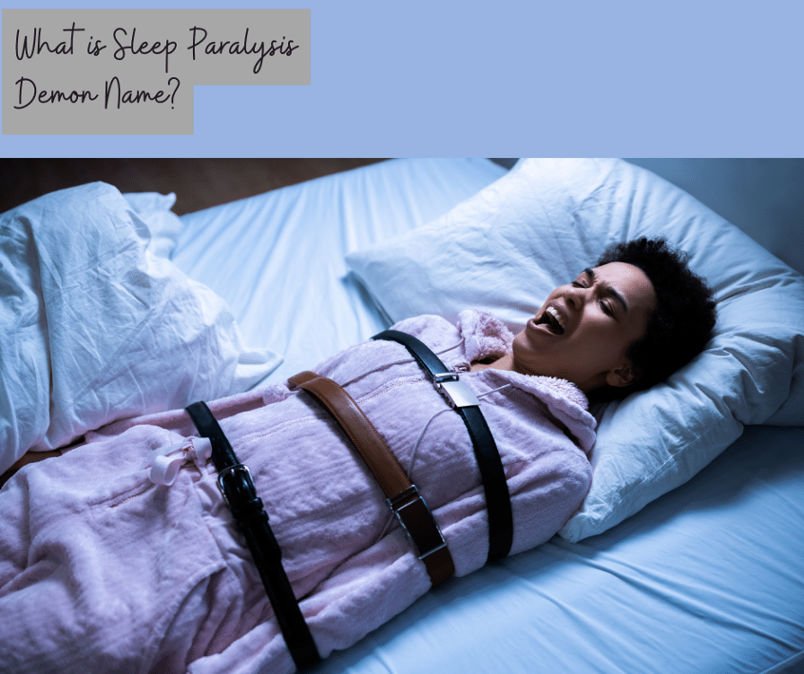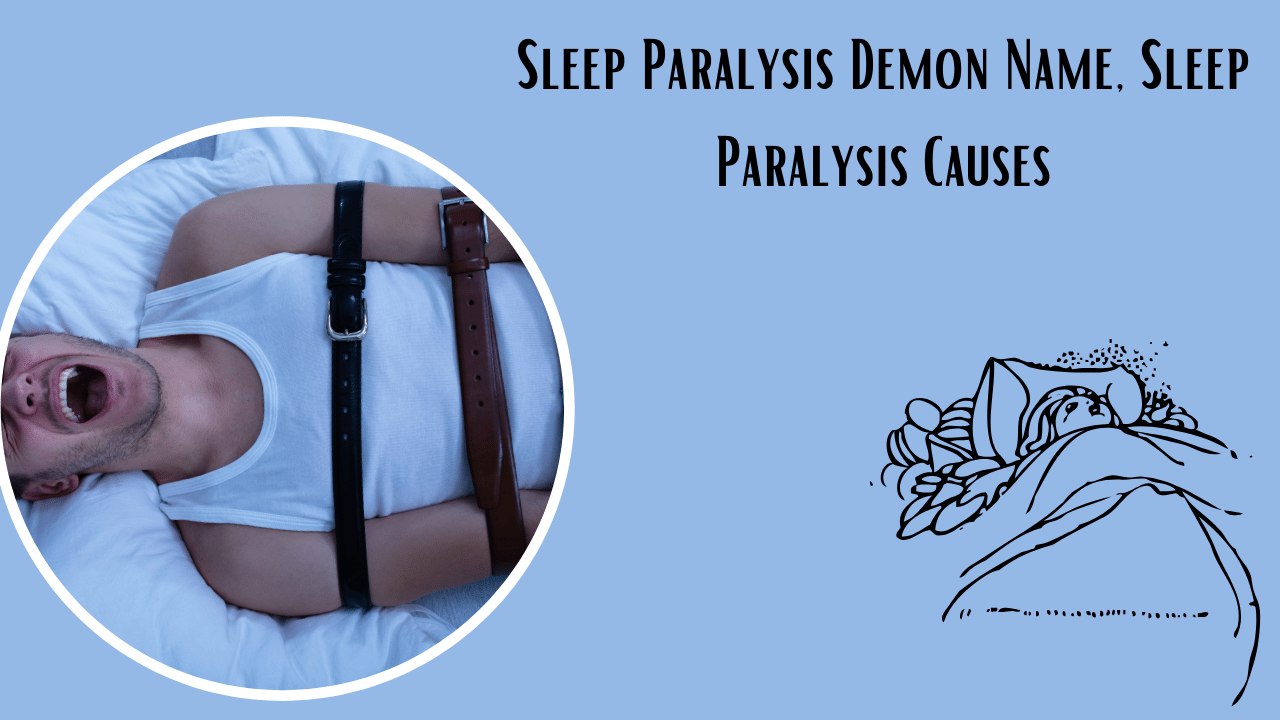You are dozing when suddenly something smothers you. You try to get out, but you can’t move your arms or legs beneath you, as if an awful thing has trapped you beneath its crushing weight.
If this sounds terrifyingly familiar, you have most definitely been visited by a “sleep paralysis demon.” The intruder is just a sleep hallucination, but the paralysis is genuine. Although frightening, the occurrence occurs when your brain becomes temporarily snagged during the transition from rapid eye movement (REM) sleep to woken state.
The scene appears to be straight from a horror film. However, sleep paralysis (and the accompanying sleep demon) affects an estimated 8% of the population. According to some research, the eerie experience may be even more widespread, with 30% of people have had at least one encounter in their lifetime.
What is sleep paralysis?

You can be certain that an ill-intentioned beast is not attempting to destroy or hurt you. However, even after the paralysis and demonic illusion have vanished, the situation can still feel terrifying and genuine.
Simply put, sleep paralysis is a medical condition in which you are caught halfway between sleep and alertness. In this state, you are aware of your surroundings, but you are still paralyzed by REM sleep and hence unable to move. Sleep paralysis is frequently associated with hallucinations as a result of the shift from dream to reality. When the brain switches on how it processes information during this transition, occasionally there is a malfunction. Even if you haven’t had a nightmare before, you may experience disorienting and even terrifying hallucinations.
It’s vital to understand that we go through numerous sleep cycles (typically four to six) per night, with each cycle divided into four stages. The first three stages of sleep are non-REM, whereas the fourth is REM. As a result, you may experience sleep paralysis in the morning or middle of the night. Sleep interruptions that wake you up from REM and prevent you from moving on to your next sleep cycle are frequently blamed for episodes that occur in the middle of the night.
Hallucinations
Along with the inability to move or talk, sleep paralysis symptoms may include a sense of an intruder and acute terror. But this invader is a delusion.
We are all susceptible to visual, aural, and sensory hallucinations while we are asleep and when we wake up. Hypnagogic hallucinations occur when we enter the first stage of sleep, which is non-REM. You can see a kaleidoscope of colors or patterns, or you might feel like you’re falling and then accidentally shock yourself awake. On the other hand, hypnopompic hallucinations happen as we wake up and leave REM sleep. They are frequently dreams that have been extended.
A sleep paralysis demon, witch, ghost, beast, or other terrifying monster is a form of hypnopompic hallucination known as the incubus phenomenon. The demons frequently assume the form of childhood fantasy villains. However, additional research is needed to determine exactly what is going on in the brain during these demonic hallucinations.
Researchers believe that people perceive a humanoid figure over them as a result of a temporary delay in how the brain processes physiological perception. When we are awake, the parietal lobe feeds us information about our body parts, including their positions and movements. By knowing where we are concerning objects, such as the coffee table, we may avoid bumping into them regularly.
Sleep paralysis causes
Sleep paralysis can strike anyone at any time. However, a systematic analysis that examined 42 papers on the subject discovered recurring features among those who have described seeing the phenomenon. If any one or more of the following conditions apply to you, you may be more susceptible to sleep paralysis:
- alcohol
- Unease
- anti-anxiety drugs
- persistent ache
- sleep paralysis in the family history
- history of sexual abuse as a child
- sadness following the death of a loved one
- The nightmare characteristics of narcolepsy
- supernatural convictions
- condition resulting from extreme stress
- inadequate sleep
- physical ailment
- cigarette use
- Lack of sleep
- disturbances to sleep
- tension
- trauma from a disaster survival from an attack
How they are described by others
What is this “demon” that entraps you in your body, preventing you from moving or screaming? Depending on who you ask.
For others, it is a faceless, shapeless presence attempting to suffocate them. Some people characterize it as an eerie, clawed old hag. Some people witness an extraterrestrial and assume they have been abducted completely. Others perceive the demons as deceased relatives.
Different civilizations have different theories about sleep paralysis demons.
The Canadian Inuit attribute sleep paralysis to shamanic magic.Japanese tradition, it is a malevolent spirit who suffocates its foes while they sleep. The demon is known as Pisadeira in Brazilian folklore, which translates as “she who steps.” She’s a crone with long fingernails who lurks on rooftops in the night, then walks on the chest of people who sleep belly up on a full stomach.
Do these ‘demons’ exist?
The short answer: somewhat of.
Paralysis is genuine. The condition is known as sleep paralysis. Sleep paralysis can lead to the perception of a demon-like figure. It is referred to as a hypnagogic or hypnopompic delusion.
The devil itself does not exist. We swear.
However, the belly-up portion of the Brazilian legend may have some reality. Sleeping on your back, it turns out, increases your chances of experiencing sleep paralysis.
What Causes a Sleep Paralysis Demon?
Although the precise source of sleep-related hallucinations is unknown, many experts believe that hallucinations during sleep paralysis occur when patients have vivid dreams of REM sleep when awake.
Researchers have thought about the impact of hormones, mirror neurons, respiratory abnormalities, and the brain’s survival regions to explain the frequently terrifying feelings during these hallucinations.
Serotonin: As a person awakens, chemicals such as serotonin decrease REM sleep and contribute to greater awareness of one’s surroundings. However, serotonin is released while a person is still in REM sleep during a sleep paralysis episode. This could cause delusions and trigger the brain’s fear circuits.
Brain disturbances: Malfunctions in the areas of the brain responsible for forming images of the body may be at the root of the appearance of human-like figures during a hallucination. These disturbances may also explain the sexual aspect of some hallucinations, as well as the phantom motions and agony that sleepers may experience in their limbs.
Breathing changes: When major muscles are immobilized during REM sleep, a person’s breathing usually becomes shallower. Being conscious of reduced breathing during an episode of sleep paralysis may explain the sensations of suffocation or chest pressure that patients express during a sleep-related hallucination.
What Leads to Hallucinations Associated with Sleep?
Although scientists do not know the specific origin, they believe that hallucinations on the outskirts of sleep are caused by dreamy sensations that persist into waking life.
As a person falls asleep, their body starts to alternate between two forms of sleep: rapid eye movement (REM) sleep and non-rapid eye movement (NREM) sleep. REM sleep causes the brain to be more active, and respiration, blood pressure, and heart rate all increase. This is also the sleep pattern associated with vivid and detailed dreams and nightmares.
Paradoxically, during REM sleep, the body enters a transient paralysis known as muscle atonia. This state is most likely a protective mechanism to keep sleepers from harming themselves while acting out their fantasies.
In sleep paralysis, the distinction between sleep and alertness becomes hazy. When a person is on the verge of awakening or falling asleep, they become aware of their surroundings while their muscle paralysis lasts for a few seconds to several minutes. This means that individuals can think, see, and breathe while lying awake, but they can’t move their bodies.
When sleep paralysis is accompanied by a sleep-related hallucination, the individual begins to see, hear, feel, or sense changes in their surroundings that do not exist. Simple, still visuals or more intricate, multimodal invader, incubus, or vestibular-motor hallucinations are examples of hallucinations.
An intruder hallucination is defined as seeing or sensing something threatening in the bedroom, such as a dangerous person or a menacing presence. Incubus hallucinations frequently coexist with this kind of hallucination.
Vestibular-motor hallucinations are imagined sensations in the body such as movement, out-of-body experiences, or emotions of joy.
Chest pressure hallucinations: Also known as incubus hallucinations, a person may believe they are suffocating or that something is pressing on their chest.
Dreams versus Delusions
Hallucinations and dreams might be difficult to differentiate, but there are several differences between the two.
People who are experiencing sleep paralysis are usually aware that they have woken up, whereas dreamers are frequently oblivious that they are asleep.
Setting: While dreams can occur anywhere and frequently feature locations outside of the home, sleep-related hallucinations coincide with reality and occur in a person’s bedroom or real-life sleep environment.
Emotions: Although certain periods of sleep paralysis may be pleasant or agreeable, up to 90% of hallucinations during sleep paralysis entail dread. In comparison, only about 30% of dreams may be described as disturbing.
Recall: While many people forget their dreams after awakening, those who have nighttime hallucinations frequently recall the event vividly.
FAQs
Is sleep paralysis related to evil?
Sleep paralysis is rarely associated with serious underlying psychological issues. Sleep paralysis symptoms have been reported in a variety of ways throughout history, and they are frequently linked to a “evil” presence, such as unseen night demons in ancient times, the old hag in Shakespeare’s Romeo and Juliet, and alien abductors.
What is the root of sleep paralysis?
Why does sleep paralysis happen? You are more likely to have dreams during the rapid eye movement (REM) stage of sleep. To protect you from hurting yourself by acting out your dreams, the brain stops the muscles in your limbs from moving. Sleep paralysis occurs when you regain awareness when in or out of REM.
Is sleep paralysis spiritual?
Examples are provided to demonstrate that, for the vast majority of participants, sleep paralysis is regarded as a spiritual experience. This is due in part to the widely held belief that the event includes a non-physical ‘threatening presence’.
What is Madzikirira?
Sleep paralysis (madzikirira) is a brief incapacity to move or talk when waking up or falling asleep, which is frequently accompanied by a sensation of pressure on your chest. You may feel as if someone is in the room, sitting on you, or attempting to choke you.
Summary
Sleep paralysis demons may not exist, but the experience of being confined in your body with their senses or visions is no less horrific. Speak with your healthcare physician if you experience these episodes frequently or if they interfere with your everyday life and cause concern.

I’m a seasoned content creator with 6+ years of experience crafting engaging, SEO-optimized content that drives traffic and rankings. I excel in keyword research, link building, and guest posting, ensuring your brand reaches new heights.

